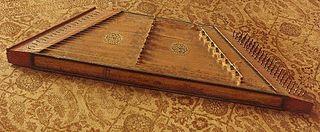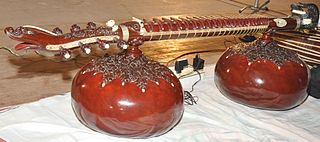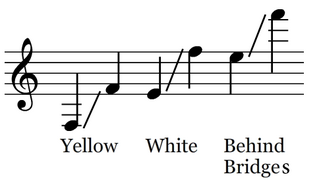
The word dulcimer refers to two families of musical string instruments.

The hammered dulcimer is a percussion-stringed instrument which consists of strings typically stretched over a trapezoidal resonant sound board. The hammered dulcimer is set before the musician, who in more traditional styles may sit cross-legged on the floor, or in a more modern style may stand or sit at a wooden support with legs. The player holds a small spoon-shaped mallet hammer in each hand to strike the strings. The Graeco-Roman word dulcimer derives from the Latin dulcis (sweet) and the Greek melos (song). The dulcimer, in which the strings are beaten with small hammers, originated from the psaltery, in which the strings are plucked.

Zithers are a class of stringed instruments. Historically, it could be any instrument of the psaltery family. In modern terminology, it is more specifically an instrument consisting of many strings stretched across a thin, flat body, the topic of this article.

A psaltery is a fretboard-less box zither and is considered the archetype of the zither and dulcimer. Plucked keyboard instruments such as the harpsichord were also inspired by it. Its resonance box is usually trapezoidal, rectangular or in the form of a "pig's head" and often richly decorated.

The gayageum or kayagum is a traditional Korean musical instrument. It is a plucked zither with 12 strings, though some more recent variants have 18, 21 or 25 strings. It is probably the best known traditional Korean musical instrument. It is based on the Chinese guzheng and is similar to the Japanese koto, Mongolian yatga, Vietnamese đàn tranh, Sundanese kacapi and Kazakh jetigen.

The trapezoidal yangqin is a Chinese hammered dulcimer, likely derived from the Iranian santur or the European dulcimer. It used to be written with the characters 洋琴, but over time the first character changed to 揚, which means "acclaimed". It is also spelled yang ch'in. Hammered dulcimers of various types are now very popular not only in China, but also Eastern Europe, the Middle East, India, Iran, and Pakistan. The instruments are also sometimes known by the names "santoor" and "cymbalom". This instrument had an influence on the Thai classical instrument, known as Khim (ขิม).

Music of Jammu and Kashmir reflects a rich musical heritage and cultural legacy of the Indian-administered union territory of Jammu and Kashmir. Two different regions of Jammu and Kashmir consists the Jammu region and Kashmir Valley. Music of Kashmir Valley has influences of Central Asian music while music from Jammu region is similar to that of other regions of North India.
The gotuvadyam is a 20 or 21-string fretless lute-style veena in Carnatic music from around the late 19th and early 20th centuries, named by Sakha Rama Rao from Tiruvidaimarudur, who was responsible for bringing it back to the concert scene.

The swarmandal, surmandal, or Indian harp is a plucked box zither, originating from India, similar to the qanun that is today most commonly used as an accompanying instrument for vocal Indian classical music. It is part of the culture of Northern India and is used in concerts to accompany vocal music. The name combines Sanskrit words svara (notes) and maṇḍala (circle), representing its ability to produce many notes. The instrument was seen as equivalent by the Ā'īn-i-akbarī to the qanun.

The khim is a stringed musical instrument derived from the Mesopotamian or Persian Santur. It is similar to the Hammered Dulcimer or Cimbalom. This khim was introduced to Thailand from China, where a similar instrument is called yangqin, and introduced to Laos and Cambodia from Thailand later. It is played with two flexible bamboo sticks with soft leather at the tips to produce a soft tone. This instrument can be played by either sitting down on the floor with the khim on the floor, or by sitting on a chair or standing while the khim is on a stand. The khim produces a bright and expressive sound when played. It is made of wood, with brass strings that are laid across the instrument. The Australian-born musician and vocal artist Lisa Gerrard specialises in the use of a khim hammered dulcimer, featuring its music on several albums and performing with the instrument live on tour.

The Rudra veena —also called Bīn in North India—is a large plucked string instrument used in Hindustani Music, especially dhrupad. It is one of the major types of veena played in Indian classical music, notable for its deep bass resonance.

The Sarasvatī vīṇa is an ancient Indian plucked veena. It is named after the Hindu goddess Saraswati, who is usually depicted holding or playing the instrument. Also known as raghunatha veena, it is used mostly in Carnatic Indian classical music. There are several variations of the veena, which in its South Indian form is a member of the lute family. One who plays the veena is referred to as a vaiṇika.

Pandit Bhajan Sopori was an Indian instrumentalist. He was a player of the santoor, an ancient stringed musical instrument.
In Arabic Music, the mawwāl is a traditional and popular Arabic genre of vocal music that is very slow in beat and sentimental in nature, and is characterised by prolonging vowel syllables, emotional vocals, and is usually presented before the actual song begins. The singer performing a mawwal would usually lament and long for something, such as a past lover, a departed family member or a place, in a wailing manner.
Damping is a technique in music for altering the sound of a musical instrument by reducing oscillations or vibrations. Damping methods are used for a number of instruments.

Abhay Rustum Sopori is an Indian Santoor player, music composer and conductor. He is the son of Santoor player Pandit Bhajan Sopori, known for his versatility, innovations and experimentation. Sopori has received awards in recognition of his contribution in the field of music, and is one of the youngest recipients of awards such as 'Bharat Shiromani Award' & 'Ustad Bismillah Khan Yuva Puraskar'. Abhay was invited to speak at the international conference TEDx.

The veena, also spelled vina, is any of various chordophone instruments from the Indian subcontinent. Ancient musical instruments evolved into many variations, such as lutes, zithers and arched harps. The many regional designs have different names such as the Rudra veena, the Saraswati veena, the Vichitra veena and others.

The santur, is a hammered dulcimer of Iranian origins.

The kinnari vina is a historical veena, a tube zither with gourds attached to act as resonators and frets. It was played in India into the late 19th century and was documented by two European artists. The instrument dates back into medieval times and possibly as far back as 500 C.E. It is closely related to the Alapini Vina and Eka-tantri Vina, the instruments having coexisted in medieval times.

















